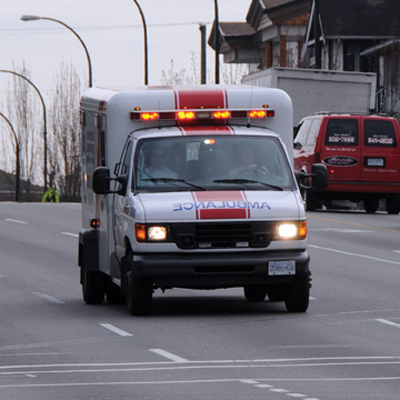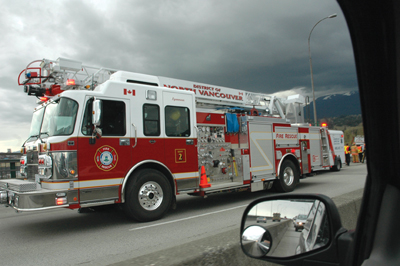
Features
Hot topics
Response
A fine balance
Forty years ago, pre-hospital emergency medical care was barely a concept. Ambulances were operated by a patchwork of public health departments, fire departments, volunteer societies and private contractors – usually the local funeral home. The term ambulance was appropriate as the service provided was principally one of transporting patients to hospitals for medical attention.
June 19, 2009
By Paul Dixon
Forty years ago, pre-hospital emergency medical care was barely a concept. Ambulances were operated by a patchwork of public health departments, fire departments, volunteer societies and private contractors – usually the local funeral home. The term ambulance was appropriate as the service provided was principally one of transporting patients to hospitals for medical attention.
 |
|
| Dispatch for B.C. ambulance’s communication centre in Vancouver is responsible for 45 ambulance stations over an area of more than 13,000 square kilometres. The region includes more than 40 fire departments for which dispatch is provided by E-Comm (the regional 9-1-1 PSAP), Surrey Fire Service and Fraser Valley Regional Fire Dispatch. Photo by Paul Dixon
|
In the 1960s, the field of emergency medicine evolved out of the hospitals and into the street with the realization that the battlefield medical protocols that were successful in drastically reducing the mortality rate in Vietnam could be applied in the civilian world with equally impressive results.
One of the first paramedic programs in North America began in Los Angeles County under the direction of a Canadian, Dr. Ronald Stewart of the University of Southern California Medical Center. While in its infancy, the program came to the attention of Jack Webb of Dragnet fame. The result was the TV show Emergency, which ran from 1972 through 1976. When the TV show first aired, there were three paramedic programs in North America, including Los Angeles. By the time Emergency had gone off the air five years later, hundreds of paramedic programs had been created in communities across North America.
Across Canada, a number of different models were employed in the development of paramedic services capable of delivering increasingly sophisticated on-scene care. At the same time, many fire departments expanded training for their personnel and acquired equipment and apparatus to enable them to provide medical first response. As a result, it was not unusual to find a number of emergency vehicles responding to a single incident, with a fire engine, rescue squad, basic life support ambulance and advanced life support arriving within minutes of each other in large urban settings. While giving the illusion of superior service, this level of response leads to severe strain on resources for even the largest fire departments.
The problem is how to meet the public’s expectations of fire and EMS responses in a timely, cost-effective way without creating new issues.
The challenge is reaching consensus among all parties as to the appropriate level of response to any particular incident – finding the point where the maximum benefit to the client can be achieved from best use of the all too often meagre resources available.
The Toronto model
Norm Lambert, deputy director of Toronto EMS and director of its Central Ambulance Communications Centre (CACC) says a solid relationship with Toronto Fire helps things run smoothly.
“We’re really lucky here. We have a very good working relationship with Toronto Fire. Our chief, along with the fire chief, police chief and regional commander of the Canadian Forces, meet on a regular basis. I meet with the deputy chief from Toronto Fire at least quarterly to discuss common issues and, if required, we will meet to discuss specific issues as they arise. Our CAD vendors [Intergraph for Toronto Fire and VisiCad for Toronto EMS] have been able to interface the two systems, allowing us to post calls directly to fire dispatch as they are created in our centre.”
Toronto EMS uses ProQA software, which categorizes incidents from A (minor) through E (immediate response required). Toronto Fire is automatically included on all D and E category calls and some C calls depending on specific determinants within the incident. Lambert says that the tiered response committee of fire and EMS, in conjunction with Sunnybrook Hospital, regularly reviews incidents to ensure that existing protocols meet the actual need. “We have a well-established tiered response committee which focuses on providing the optimal response.”
Co-operation in Nova Scotia
Nova Scotia’s Emergency Health Services (EHS) is responsible for providing province-wide, pre-hospital emergency medical care, though the actual service is operated by a private contractor – Emergency Medical Care Inc. One dispatch centre in Dartmouth provides service to the province. There is an active first-responder program in Nova Scotia but outside central Halifax and Sydney, it is mostly volunteer fire departments.
Bernie Turpin, administrative chief with Halifax Regional Fire Service, says it is a big advantage to work with the one ambulance service for the entire municipality. “The response time for in our rural areas is generally within 15 minutes for fire crews, whereas the ambulance can be up to 25 minutes”.
Jeff Fraser, manager of the Nova Scotia EMS communication centre, validates the role of medical first responders as vital, describing them as “the heart and soul” of the emergency medical response system. With fire departments usually better positioned to arrive before the ambulance, it means there will be a confirmation of the location of the incident, as well as an update on patient status. While Nova Scotia fire departments across the province are on a variety of VHF and UHF systems. To expedite communications, every first response agency in the province has been given a Motorola radio so responders can communicate directly with EMS. Fraser says having the radio link allows his staff to give direction to first responders who find themselves in situations beyond their level of training while the ambulance is still en route. “We will do everything we can to set a call up for success.”
British Columbia’s E-Comm system
In 1974, the British Columbia Ambulance Service (BCAS) was created by the provincial government under the Emergency Health Services Act to assume responsibility for all privately and municipally operated ambulance services in the province. Today, the BCAS Lower Mainland Communications Centre in Vancouver is responsible for 45 ambulance stations over an area of southwestern B.C. covering more than 13,000 square kilometres with a population in excess of three million. Within this region are more than 40 fire departments, ranging from large urban departments such as Vancouver City to smaller, composite suburban departments down to isolated rural departments crewed entirely by volunteers. Dispatch for these fire departments is provided by three large centres; E-Comm (the regional 9-1-1 PSAP), Surrey Fire Service and Fraser Valley Regional Fire Dispatch, while two departments maintain their own stand-alone dispatch operations.
 |
|
| Using the ProQA determinates, BCAS will “fire” all “D” and “E” calls and some “C” calls. Photo by Paul Dixon
|
BC Ambulance is on the same Intergraph CAD system as the fire dispatch at E-Comm. Using the ProQA software package, when an incident is created and posted to dispatch, if it meets the predetermined criteria for tiered response, the call will be simultaneously posted to the fire dispatch position at E-Comm. While the other fire dispatch centres in the region do not have Intergraph CAD, BCAS has provided each centre with an Intergraph terminal. This was done as a low-cost workaround when estimates for actually interfacing the different CAD systems proved prohibitive. The incident is simultaneously transmitted to the CAD terminal in the appropriate dispatch centre, but it must be manually re-keyed into the other centre’s CAD. One position in the BCAS communications centre is dedicated to monitoring tiered responses. If the fire dispatch centre has not acknowledged receipt of the incident within two minutes, BCAS will contact the fire dispatch by phone to verify receipt.
Using the ProQA determinates, BCAS will “fire” all “D” and “E” calls and some “C”. As Derek McClure, superintendent of the BCAS Lower Mainland Dispatch/Communications Centre, explains, “the decision to include the fire agency in the dispatch is written into the software. It is not left up to the call taker or dispatcher to decide whether or not to call the fire department. We send everything to fire that should be sent to fire as set out in our protocols.”
What is different from other areas is that not all fire agencies in the region are medical first responders. Even so, all calls are sent to the appropriate fire dispatch agency and the decision is made at that point whether the incident is within the dispatch parameters for the particular fire agency. Fire dispatch will acknowledge receipt of the incident from BCAS by responding either “fire responding” or “fire not responding.”
In a step to improve overall fire response times, E-Comm is now employing Locution automated dispatch and fire station alerting system for its fire dispatch service. While the company claims that agencies using its products are “out the door” 30 seconds faster than using conventional voice dispatch, E-Comm’s Director of IT, Glen Miller, says it is too early to make a definitive statement.
In the Metro Vancouver area, BCAS is on the E-Comm EDACS trunked radio system, as are all police agencies in the same region, but only some of the fire departments. In the Fraser Valley, Sea to Sky corridor and Sunshine Coast, BCAS is on the legacy VHF system. This necessitates two radio systems in the ambulances that work in both areas and along the overlap zones. Within the EDACS system, channel 14 has been designated as the PFA (police/fire/ambulance) talk group on all radios. A joint project by BCAS, RCMP, Richmond Fire, Canadian Coast Guard and E-Comm developed a protocol known as combined events whereby police, fire, ambulance and even the Coast Guard hovercraft responding to the same incident could use the PFA talk group to talk to the other responding units. The project was first implemented in Richmond in 2005 and proved hugely successful, as it enabled first responders from all agencies to identify themselves to each other while en route to the call and tell each other what their ETA would be or offer information such as better location details, etc.
Based on the success of the Richmond trial, PFA has been extended to the other municipalities in Metro Vancouver where police, fire and ambulance share the trunked radio system.
Print this page